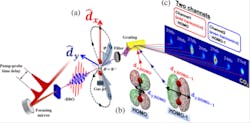2D high-harmonic spectroscopy sees multiple molecular orbitals
The Institute for Basic Science (IBS; Daejeon, Korea) has created a new technique for resolving the orbits of multiple molecular orbitals—a previously impossible feat. Professor Hyeok Yun and his team from IBS and the Gwangju Institute of Science and Technology (GIST) have moved a step closer to fully understanding the complicated relationship between the form and motion of molecules.
RELATED ARTICLE: High harmonic generation pushes spectroscopy to the cutting edge
The researchers say that the structure and movement of molecules is not feasible to observe via conventional microscopic methods. To get information about molecular shape and the orientation of their orbits, researchers use a process called high harmonic generation (HHG) wherein a laser pulse tuned to a specific high frequency is directed into a jet of gas of the molecule being studied. When the pulse meets the jet of gas, a wavelength-specific plasma is generated; this interaction between the molecule and light reveals the highest-occupied molecular orbital (HOMO) which is envisioned as the “shape” of the outside molecular orbits.
The pulsed laser beam is then converted to a high harmonic frequency that reaches the sensor where data from the interaction can be collected, allowing the researchers to gather information about the characteristics of a molecule’s structure and dynamics.
But as useful as this technology is, researchers have been limited in what information they can obtain because they have been confined to observing the high harmonic frequency from a single laser pulse on a one-dimensional plane each time.
To gather more information from the molecules during each test, Professor Yu’s team devised a method for resolving multiple molecular orbitals by using two-dimensional (2D) high-harmonic spectroscopy (HHS) that involves pulsing a laser at an ultrafast interval through a polarizing lens that splits the beam in two.
The team focused the laser through a thin crystal that split the beam into two polarized waves traveling in the same direction but now perpendicular to each other. With one beam traveling up and down while the other is moving side to side, the beams are moving orthogonally. When the two beams interact with the gas sample, they reveal not only the HOMO, but simultaneously the HOMO-1, a lower-lying molecular orbit. In the past these two orbits have been difficult to distinguish from one another because HOMO-1 has been overshadowed by the more energetic HOMO. According to Yun, “In this work, we approached molecules in two dimensions. HOMO-1 can be revealed with relative ease in the orthogonal direction to the molecular axis, while HOMO does it in a parallel direction. Orthogonally polarized two waves enable us to probe both orbitals in two dimensions and to separate signals to different harmonic frequencies. Thus, we could resolve the signals from the two orbitals and could simultaneously obtain information on both orbitals.”
After combining the data collected from each laser pulse, the researchers use tomography to piece the 2D images together into a 3D approximation. With this approximation, they are able discern the shape and relative alignment of the HOMO and HOMO-1 orbitals, something that the researchers say has never been done before.
"The ultimate goal," says Yun, "is to follow a chemical reaction in its own time scale. It leads us to have direct insight and to understand fundamental mechanism about transformations in molecular scale. We expect this method can be a route or be of help to achieve the goal."
This new method should advance future molecular research by allowing for independent and simultaneous observation of the structures and dynamics of multiple molecular orbitals. It will enable the observation of multi-orbital dynamics during chemical reactions of more complicated molecules.

Gail Overton | Senior Editor (2004-2020)
Gail has more than 30 years of engineering, marketing, product management, and editorial experience in the photonics and optical communications industry. Before joining the staff at Laser Focus World in 2004, she held many product management and product marketing roles in the fiber-optics industry, most notably at Hughes (El Segundo, CA), GTE Labs (Waltham, MA), Corning (Corning, NY), Photon Kinetics (Beaverton, OR), and Newport Corporation (Irvine, CA). During her marketing career, Gail published articles in WDM Solutions and Sensors magazine and traveled internationally to conduct product and sales training. Gail received her BS degree in physics, with an emphasis in optics, from San Diego State University in San Diego, CA in May 1986.
